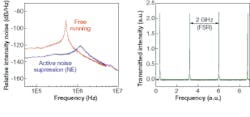SOLID-STATE LASERS: Monolithic single-frequency Yb:YAG laser emits 1 W at 1.03 µm
The high stability of a single-frequency laser system depends on the mechanical and optical stability of its oscillator. Back in 1985, Thomas Kane and Robert Byer of Stanford University (Palo Alto, CA) invented a diode-pumped monolithic nonplanar ring oscillator (NPRO) entirely integrated in a Nd:YAG crystal, and thus extremely stable.1 This was followed by further developments by researchers at Laser Zentrum Hannover and its spin-off company InnoLight (both of Hannover, Germany). Their results led to the development of Nd:YAG laser systems used for challenging tasks such as the detection of gravitational waves and high-precision optical frequency standards.
Now, engineers at InnoLight have transferred this design to a Yb:YAG NPRO that is pumped by two diode lasers at 940.5 nm, emits at 1.03 µm, and produces a continuous-wave single-frequency room-temperature output power higher than any conventional single-frequency Yb:YAG oscillator.2 Because Yb:YAG is a quasi-three-level system with significant thermal population of the lower laser level, additional pump intensity is required to reach inversion; also, strong reabsorption losses occur in unpumped regions. Frequency-doubled Yb:YAG NPROs have the advantage that they can be locked to transitions of the iodine molecule, which is spectrally narrower than what is reachable by frequency-doubled Nd:YAG radiation, enabling metrology of higher precision.
Compound laser crystal
The new ring laser differs from the Nd:YAG version by the replacement of a monolithic crystal with a compound crystal made of a central, laser-active portion of Yb:YAG doped to 5 at.% sandwiched within two pure diffusion-bonded YAG caps (see Fig. 1). The induced wave travels around unidirectionally using three surfaces for total internal reflection and the incoupling surface for outcoupling. That surface is dielectrically coated for high transmission at the pump wavelength and a few percent transmission at the laser wavelength.
Generally, ring lasers have the advantage of dispensing with standing waves that could favor mode competition; instead, traveling waves consume the entire gain. When the wave travels unidirectionally, considerable power can be reached and, together with mode-selective pumping, single-frequency laser emission is achieved at the fundamental (TEM00) mode. Stable unidirectional operation is achieved for the Yb:YAG NPRO in the same way as for the common Nd:YAG NPRO; that is, by using an optical diode formed by the combination of a strong permanent magnetic field, the nonplanar beam path, and polarization-dependent outcoupling of the coated front surface of the crystal. The pure YAG caps of the crystal serve to minimize reabsorption losses in unpumped regions caused by the quasi-three-level system, and to eliminate any possibility that standing waves near the front reflection area might cause mode competition. Residual absorption in the gain media is reduced by pumping the crystal from two directions through the front surface.
The crystal temperature was held precisely at 20°C. The laser pump threshold was 1.63 W; at 4.6 W pumping power, a 1 W TEM00 single-frequency output was achieved with a slope efficiency of 45%.
For frequency stabilization, active frequency tuning is required. At 500 mW emission, mode-hop-free frequency tuning could be achieved over 9 GHz by changing the crystal temperature, with a 32 GHz total range. Wider tuning was achieved by varying the pump power: when laser output was varied from 1 to 0.5 W, a frequency shift of about 100 GHz was measured, allowing many iodine transitions to be reached. Fast frequency tuning can be achieved with a piezoelectric transducer with sufficiently high bandwidth.Laser-intensity noise strongly influences the frequency-stabilization accuracy. The intensity noise was actively reduced using a feedback-control loop (see Fig. 2) for which a small fraction of the laser light was detected with a fast photodiode. The control loop converted this signal to a small drive current acting on the laser diodes. For the Yb:YAG NPRO a noise suppression of up to 40 dB was demonstrated, which is similar to that for common Nd:YAG NPROs. The laser’s power, stability, and tunability make it well suited for ultraprecise metrology.
REFERENCES
1. T.J. Kane and R.L. Byer, Optics Letters 10, 65 (1985).
2. P. Burdack et al., Optics Express 14 (10) (2006).
Uwe Brinkmann | Contributing Editor, Germany
Uwe Brinkmann was Contributing Editor, Germany, for Laser Focus World.
Peer Burdack | Head of Research and Development, InnoLight
Peer Burdack is head of research and development at InnoLight (Hannover, Germany).

